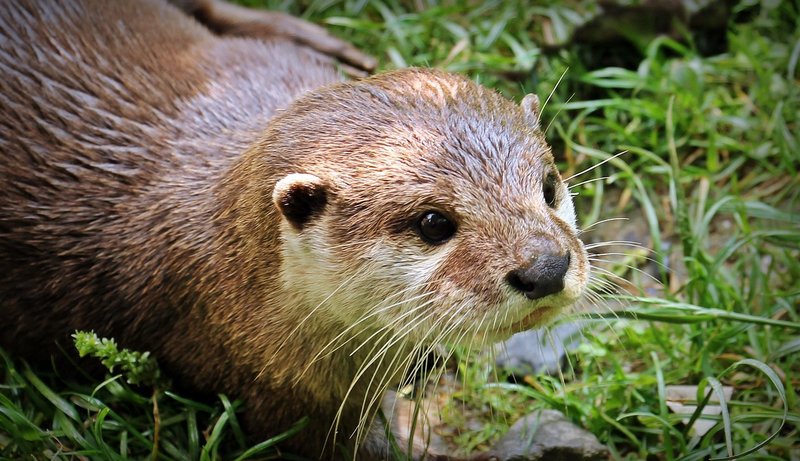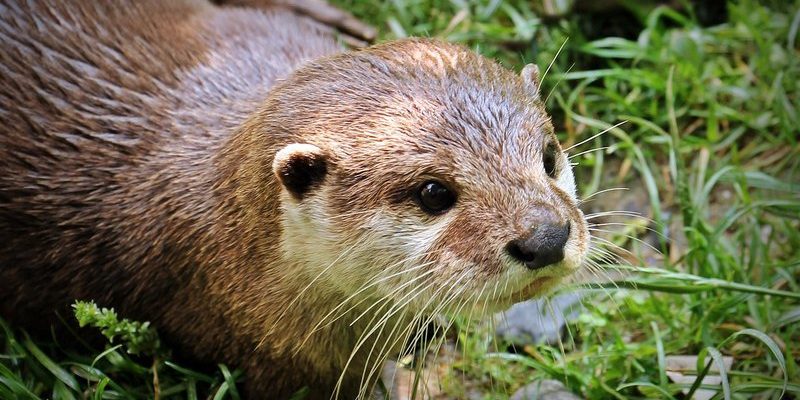
Imagine a playful creature that glides through the water with the grace of a ballet dancer while also showing off their charming personality. That’s the otter for you! These furry mammals are not just adorable; they are fascinating animals with unique habits and habitats. Otters belong to the family Mustelidae, which includes weasels and badgers, and they’re known for their playful nature and intelligence.
Otters live in a variety of environments, from rivers and lakes to coastal areas. They thrive in both freshwater and saltwater, which makes them quite adaptable. You might have seen videos of otters floating on their backs, cracking open shells with stones, and playing with their friends. They are social beings, often seen in groups called rafts. This playful behavior isn’t just for fun; it’s a vital part of their social structure and hunting skills.
What Do Otters Look Like?
Otters are easily recognizable due to their streamlined bodies, short legs, and thick fur. Their fur is not just for show; it keeps them warm and dry while they swim. Depending on the species, otters can range in size from the small Asian small-clawed otter, which measures about 2 to 3 feet in length, to the large North American river otter, which can grow up to 5 feet long! They typically weigh between 50 to 100 pounds.
One of the most distinguishing features of otters is their webbed feet, which make them excellent swimmers. Their tails are long and muscular, helping them maneuver quickly through the water. Otters also have sharp claws that assist them in catching their prey, whether that’s fish, crabs, or even small mammals. The dense layer of fur is a thick coat that helps water slide off easily so they can maintain their body heat.
Habitat and Distribution
Otters are found all over the world, inhabiting various environments. From the lush wetlands of North America to the coastal regions of Europe and Asia, otters adapt well to their surroundings. They typically prefer habitats with plenty of water, such as rivers, lakes, marshes, and coastal areas. Their presence often indicates a healthy aquatic ecosystem.
In North America, you might find the North American river otter making homes near rivers and lakes. In contrast, the sea otter is often found in marine environments along the Pacific coast. Otters are also prevalent in Europe, where the Eurasian otter thrives in freshwater and brackish environments. The adaptability of otters is remarkable, and they often travel great distances in search of food or better territory.
Diet and Feeding Habits
Otters are carnivorous and have a varied diet that largely depends on their habitat. They primarily eat fish, crustaceans, mollusks, and sometimes small mammals and birds. That means otters are not picky eaters, which allows them to thrive in different environments. A single otter can consume up to 20% of its body weight in food each day!
One interesting aspect of otter feeding habits is their use of tools. Sea otters are known to use rocks to crack open the hard shells of sea urchins and clams. This behavior shows their intelligence and adaptability, as they can use whatever tools are available to them in their environment. When hunting, otters often dive underwater to search for prey, holding their breath for several minutes at a time.
Social Structure and Behavior
Otters are incredibly social animals. They often live in family groups or larger communities called rafts. These groups provide protection and support when foraging for food. Otters engage in various social behaviors, including grooming, playing, and even sliding down mud or snowbanks together. This playful interaction strengthens their bonds within the group.
When it comes to communication, otters have a range of sounds they use to express themselves—from high-pitched whistles to low growls. You might find them vocalizing during playtime or alerting their group to potential threats. Furthermore, otters are also known to use scent marking to communicate with one another, leaving their markings to establish territory.
Reproduction and Lifecycle
Otters typically reach sexual maturity around two years of age, and the breeding season varies depending on the species and location. After a gestation period of about 60 to 86 days, female otters give birth to a litter of pups. These adorable little otters are born blind and helpless, relying on their mothers for care and protection. They often stay with their mothers for several months before venturing out on their own.
During the first few weeks of life, otter pups are kept in a safe den where the female can care for them. As they grow, they become more adventurous and start to learn essential survival skills, such as swimming and hunting. It’s fascinating to watch them develop from innocent pups into skilled hunters, ready to take on the world!
| Characteristic | Details |
| Size | 2 to 5 feet long depending on species |
| Weight | 50 to 100 pounds |
| Habitat | Freshwater and marine environments |
| Diet | Fish, crustaceans, mollusks |
| Lifespan | 8 to 12 years in the wild |
| Social Structure | Live in family groups or rafts |
Conservation Status
Otters face various threats due to habitat loss, pollution, and climate change. Many otter species have seen their populations decline, leading conservationists to take action. Organizations focus on protecting water quality and habitats where otters thrive, ensuring these charming creatures continue to play in our rivers and coastlines.
Some species, like the sea otter, have been particularly hard hit due to historical hunting for their fur and ongoing environmental pressures. Thankfully, with the implementation of protective laws and conservation efforts, the numbers of some otter species are beginning to rebound. We can all play a part in protecting otters by supporting local conservation efforts and being mindful of our water usage.
Interesting Facts About Otters
- They have a thick coat of fur with up to a million hair follicles per square inch.
- Sea otters have a favorite rock they use to crack open shells and carry it under their arms.
- Otters have a playful side that includes sliding down snow or mud banks for fun.
- They can hold their breath for up to five minutes while diving for food.
FAQ
What are the different types of otters?
There are several species of otters, each adapted to their specific environments. The North American river otter is the most common type found in freshwater. Sea otters, primarily located along the Pacific coast, are known for their thick fur and playful nature. Other notable species include the Eurasian otter, Asian small-clawed otter, and the giant river otter found in South America. Each of these species has unique characteristics and behaviors that help them thrive in their respective habitats.
How do otters keep their fur clean and dry?
Otters are meticulous groomers. They spend a significant amount of time cleaning their fur to keep it in top condition. The dense fur repels water, but if it does get wet, they have a special grooming routine to dry it out. Otters often roll on land or use their paws to fluff their fur, ensuring that air can circulate through it. This grooming behavior is essential for maintaining insulation and buoyancy while swimming.
Are otters dangerous to humans?
Generally, otters are not dangerous to humans. They are curious and playful creatures that tend to avoid human contact. However, like any wild animal, they can become aggressive if threatened or cornered. It’s best to observe otters from a distance and not approach them in the wild, as they may feel defensive about their territory or young.
Can otters swim well?
Yes, otters are exceptional swimmers! They have well-adapted bodies, with webbed feet that help them glide effortlessly through the water. Their streamlined shape and strong tails enable them to propel themselves quickly. Otters can hold their breath for several minutes while they dive to catch prey, showcasing their impressive swimming abilities.
Do otters have predators?
While otters are agile and clever, they do have natural predators. Larger carnivores, such as alligators, crocodiles, and some big cats, may hunt otters. Birds of prey, like eagles, can also pose a risk to juvenile otters. To evade these threats, otters rely on their agility in the water and their social structure, staying close to their groups for added protection.
How long do otters live?
In the wild, otters typically live between 8 to 12 years, depending on their species and environmental conditions. However, some otters in captivity can live much longer due to the absence of predators and improved access to food. Lifespan can vary significantly based on habitat, food availability, and threats from humans and other animals.
What do baby otters look like?
Baby otters, also known as pups, are incredibly cute and come into the world blind and helpless. At birth, they are small and furry, weighing only a few ounces. As they grow, they develop their distinctive traits, including webbed feet and thick fur. They rely heavily on their mothers for nourishment and protection in these early stages of life, spending several months with her before venturing out on their own.
How do otters communicate?
Otters use a variety of vocalizations to communicate with one another. These sounds range from chirps and whistles to growls and screams, each serving a different purpose. Vocal communication is particularly common during play or when establishing social bonds. Additionally, otters use scent marking to communicate territory and reproductive status, making them quite interesting creatures to study.
What is the role of otters in the ecosystem?
Otters play a crucial role in their ecosystems. They help maintain healthy fish populations by preying on weaker individuals, which supports the overall health of aquatic environments. In coastal areas, sea otters eat sea urchins that can devastate kelp forests if left unchecked. By controlling these populations, otters contribute to the balance of their habitats, highlighting the interconnectedness of wildlife.
How can we help protect otters?
There are many ways we can support otter conservation efforts. One of the most impactful actions is to support organizations focused on habitat restoration and protection. Reducing pollution, particularly in waterways, is crucial as well. You can also educate others about the importance of otters and their ecosystems, fostering a broader appreciation for these remarkable creatures. Lastly, participating in local clean-up efforts or conservation programs can help protect habitats where otters thrive.

